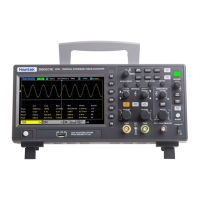SCPI Programmers Manual
2
Introduction to SCPI commands
SCPI is the abbreviation of Programmable Instrument Standard Commands. It defines a set of standard
syntax and commands for controlling programmable test and measurement instruments. SCPI
commands are ASCII strings that are passed into the instrument through the physical transport layer.
The command consists of a series of keywords, and some also need to include parameters. In the
protocol, the command is specified as the following form: CONFigure. In use, you can either write the
full name or only the abbreviation that contains only uppercase letters. Usually, the feedback of the
instrument to the query command is also an ASCII code.
Command format
Commands usually begin with a colon ":". Keywords are separated by a colon ":", and keywords are
followed by optional parameter settings. A question mark "?" is added after the command line to
indicate that this function is being queried. The command keyword and the first parameter are
separated by a space.
For example:
:ACQuire:TYPE
:ACQuire:TYPE?
ACQuire is the root keyword of the command, and TYPE is the second-level keyword. The command
line starts with a colon ":", and the keywords of each level are separated with a colon ":". indicates a
parameter that can be set. The question mark "?" Indicates a query. Command keyword: ACQuire:
TYPE and parameter are separated by spaces.
In some commands with parameters, multiple parameters are usually separated by a comma ",",
for example:
[:TRACe[<n>]]:DATA:VALue volatile,<points>,<data>
Symbol Description
The following symbols are not sent with the command.
1. Braces {}
The contents of the braces are parameter options. Parameter items are usually separated by a vertical
bar "|". When using a command, you must select one of the parameters.
2. Vertical bar |
Vertical bar is used to separate multiple parameter options. One of the parameters must be selected
when using the command.
3. Square brackets []
The content in square brackets is omissible.
4. Triangle brackets <>
The parameters in the triangle brackets must be replaced with a valid value.
Command abbreviation
All commands are not case sensitive, you can use all uppercase or lowercase. But if you want to
abbreviate, you must enter all capital letters in the command format.

